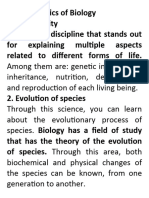Biology As Level
Biology As Level
Uploaded by
Mal EficentCopyright:
Available Formats
Biology As Level
Biology As Level
Uploaded by
Mal EficentOriginal Title
Copyright
Available Formats
Share this document
Did you find this document useful?
Is this content inappropriate?
Copyright:
Available Formats
Biology As Level
Biology As Level
Uploaded by
Mal EficentCopyright:
Available Formats
Biology
Biology is a natural science discipline that studies living things. It is
a very large and broad field due to the wide variety of life found on
Earth, so individual biologists normally focus on specific fields.
These fields are either categorized by the scale of life or by the
types of organisms studied.
, study of living things and their vital processes. The field deals with all the physicochemical aspects
of life. The modern tendency toward cross-disciplinary research and the unification of scientific
knowledge and investigation from different fields has resulted in significant overlap of the field of
biology with other scientific disciplines. Modern principles of other fields—chemistry, medicine,
and physics, for example—are integrated with those of biology in areas such as biochemistry,
biomedicine, and biophysics.
Biology is subdivided into separate branches for convenience of study, though all the subdivisions
are interrelated by basic principles. Thus, while it is custom to separate the study of plants (botany)
from that of animals (zoology), and the study of the structure of organisms (morphology) from that
of function (physiology), all living things share in common certain biological phenomena—for
example, various means of reproduction, cell division, and the transmission of genetic material.
Biology is often approached on the basis of levels that deal with fundamental units of life. At the
level of molecular biology, for example, life is regarded as a manifestation of chemical
and energy transformations that occur among the many chemical constituents that compose an
organism. As a result of the development of increasingly powerful and precise laboratory
instruments and techniques, it is possible to understand and define with high precision and accuracy
not only the ultimate physiochemical organization (ultrastructure) of the molecules in living matter
but also the way living matter reproduces at the molecular level. Especially crucial to those advances
was the rise of genomics in the late 20th and early 21st centuries.
Cell biology is the study of cells—the fundamental units of structure and function in living
organisms. Cells were first observed in the 17th century, when the compound microscope was
invented. Before that time, the individual organism was studied as a whole in a field known
as organismic biology; that area of research remains an important component of the biological
sciences. Population biology deals with groups or populations of organisms that inhabit a given area
or region. Included at that level are studies of the roles that specific kinds of plants and animals play
in the complex and self-perpetuating interrelationships that exist between the living and the
nonliving world, as well as studies of the built-in controls that maintain those relationships naturally.
Those broadly based levels—molecules, cells, whole organisms, and populations—may be further
subdivided for study, giving rise to specializations such as morphology, taxonomy, biophysics,
biochemistry, genetics, epigenetics, and ecology. A field of biology may be especially concerned with
the investigation of one kind of living thing—for example, the study of birds in ornithology, the study
of fishes in ichthyology, or the study of microorganisms in microbiology.
You might also like
- Rod Puppets & Table Top PuppetsDocument359 pagesRod Puppets & Table Top Puppetsdaniel toledo93% (27)
- biology defination and creationDocument2 pagesbiology defination and creationkemihretbelay2127No ratings yet
- What Is BiologyDocument3 pagesWhat Is BiologyYerda SakkeNo ratings yet
- What Are The Four Importance of BiologyDocument1 pageWhat Are The Four Importance of BiologyRin Okumura YukioNo ratings yet
- Fundamentals of BiologyDocument40 pagesFundamentals of Biologycutemano1311No ratings yet
- The Study of BiologyDocument14 pagesThe Study of BiologyPrincess AkariNo ratings yet
- Field Life: Biology, Study of Living Things and Their Vital ProcessesDocument1 pageField Life: Biology, Study of Living Things and Their Vital ProcessesJann MzNo ratings yet
- Framework of UnderstandingDocument4 pagesFramework of UnderstandingBojo FamaNo ratings yet
- Complete List of All Branches of Biology for SSC – Notes in PDF!Document17 pagesComplete List of All Branches of Biology for SSC – Notes in PDF!gkdfcgbxncNo ratings yet
- Biology: The Fascinating Study of LifeDocument2 pagesBiology: The Fascinating Study of LifeHardik AhujaNo ratings yet
- What Is Biology?Document2 pagesWhat Is Biology?Japeyk.Gaming OfficialNo ratings yet
- Biology Definition, History, Concepts, Branches, & Facts BritannicaDocument1 pageBiology Definition, History, Concepts, Branches, & Facts BritannicaDiamant MusicNo ratings yet
- Portfolio in Science: Rhea Joy S. ArenqueDocument16 pagesPortfolio in Science: Rhea Joy S. ArenqueCRING TVNo ratings yet
- Branches of Biology Daca19d2Document13 pagesBranches of Biology Daca19d2Sarah Alchea Alcover ResponsoNo ratings yet
- Ken (Portfolio)Document18 pagesKen (Portfolio)CRING TVNo ratings yet
- Introduction To Biology Class IxDocument9 pagesIntroduction To Biology Class Ixrabeet notofficialNo ratings yet
- Introduction To BiologyDocument4 pagesIntroduction To BiologyEury Marc Suhi-anNo ratings yet
- Lecture 01 Introduction To BiologyDocument2 pagesLecture 01 Introduction To Biologymohamedlaissani209No ratings yet
- Biology Goals and ObjectivesDocument5 pagesBiology Goals and Objectivesfaye cajigasNo ratings yet
- Physiology (Academic Script) : Course NameDocument13 pagesPhysiology (Academic Script) : Course NameKumar KNo ratings yet
- BiologyDocument4 pagesBiologyLae Nicole EvangelistaNo ratings yet
- Morphology of Livng ThingsDocument9 pagesMorphology of Livng ThingsBalarabe EL-Hussain100% (1)
- Biology Term PaperDocument14 pagesBiology Term PaperUnica HijaNo ratings yet
- Untitled DocumentDocument2 pagesUntitled Documentsiddiquigujjar551No ratings yet
- BiologyDocument2 pagesBiologydkmusicdk1No ratings yet
- EN BIO - Learning Activity 1 (Essay)Document3 pagesEN BIO - Learning Activity 1 (Essay)JOY ABRASALDONo ratings yet
- BASICS of ORAL PHYSIOLOGY (Part 1)Document171 pagesBASICS of ORAL PHYSIOLOGY (Part 1)Balarabe EL-HussainNo ratings yet
- Natural ScienceDocument5 pagesNatural ScienceHilal KhattakNo ratings yet
- Learn About The Branches of BiologyDocument13 pagesLearn About The Branches of BiologyjayavardhanaNo ratings yet
- Biology, Hour 1 - Class NotesDocument1 pageBiology, Hour 1 - Class NotescauxewNo ratings yet
- Characteristics of BiologyDocument15 pagesCharacteristics of BiologyScribdTranslationsNo ratings yet
- PHYSIOLOGYDocument6 pagesPHYSIOLOGYlorainemaysibayangamisNo ratings yet
- Scope of BiologyDocument5 pagesScope of Biologyvita ifNo ratings yet
- Biology: Natural Science Life Living OrganismsDocument5 pagesBiology: Natural Science Life Living OrganismsYam MuhiNo ratings yet
- BIOLOGY: A Career: Ronilo Jose D. Flores Faculty, Environmental Biology Division, IBS, UPLBDocument22 pagesBIOLOGY: A Career: Ronilo Jose D. Flores Faculty, Environmental Biology Division, IBS, UPLBRonilo Jose Danila FloresNo ratings yet
- PT1 Martirez, Tristan Mark, CasinilloDocument2 pagesPT1 Martirez, Tristan Mark, Casinillotm.cmrtzNo ratings yet
- EN BIO - Learning Activity 1 (Essay)Document3 pagesEN BIO - Learning Activity 1 (Essay)JOY ABRASALDONo ratings yet
- Biological ScienceDocument2 pagesBiological ScienceDonnie Ray LucioNo ratings yet
- BiologyDocument2 pagesBiologyDejhay RuslinNo ratings yet
- Spot Senior Space Science Booklet 2023 24 90595Document61 pagesSpot Senior Space Science Booklet 2023 24 90595ananya.dguptaNo ratings yet
- STB 111 (2011)Document9 pagesSTB 111 (2011)Balarabe EL-Hussain100% (1)
- Genbio Week 1 Handout 1Document37 pagesGenbio Week 1 Handout 1norpower23No ratings yet
- STB 111 (2011)Document26 pagesSTB 111 (2011)Balarabe EL-Hussain40% (5)
- Spot SyllabusDocument61 pagesSpot SyllabusManya TargotraNo ratings yet
- Chapter 1 The Science of LIfeDocument33 pagesChapter 1 The Science of LIfeNur-aine HajijulNo ratings yet
- Scribd 1Document14 pagesScribd 1'Prasada WedatamaNo ratings yet
- BiologyDocument2 pagesBiologyPRINTDESK by DanNo ratings yet
- Biology: ScienceDocument4 pagesBiology: ScienceAngel ReyesNo ratings yet
- Lesson 1Document2 pagesLesson 1Eloisa Marie IglesiasNo ratings yet
- EARTH AND LIFE SCIENCE ActivityDocument3 pagesEARTH AND LIFE SCIENCE Activityhershymae.0No ratings yet
- Botany 2021Document86 pagesBotany 2021yuolakuacyuolyarNo ratings yet
- All Branches of BiologyDocument31 pagesAll Branches of BiologyYhan Brotamonte Boneo100% (1)
- Explain How Biology Can Be Studied From A Microscopic Approach To Global - Approach. (Indicate The Unifying Themes Where The Study of Biology Is Being - Anchored) .Document3 pagesExplain How Biology Can Be Studied From A Microscopic Approach To Global - Approach. (Indicate The Unifying Themes Where The Study of Biology Is Being - Anchored) .ayeen nicoleNo ratings yet
- What Is Biology?Document3 pagesWhat Is Biology?Aljonian PaeteNo ratings yet
- TO Biology: Chapter # 1Document7 pagesTO Biology: Chapter # 1K Mürtüzå SyedNo ratings yet
- Biology: Biology Deals With The Study of andDocument3 pagesBiology: Biology Deals With The Study of andMariel CuaresNo ratings yet
- Zool 100 Lecture 1Document10 pagesZool 100 Lecture 1cwangila241No ratings yet
- Concise Dictionary Of BiologyFrom EverandConcise Dictionary Of BiologyRating: 5 out of 5 stars5/5 (1)
- 3rd Grade Science: Life Sciences in Eco Systems | Textbook EditionFrom Everand3rd Grade Science: Life Sciences in Eco Systems | Textbook EditionNo ratings yet
- Fundamentals of Microbiome Science: How Microbes Shape Animal BiologyFrom EverandFundamentals of Microbiome Science: How Microbes Shape Animal BiologyRating: 3 out of 5 stars3/5 (2)
- Acfrogc2yp5lzwqkfqhz4rokptoy1awhrg4wffjihiirbskayrpixk2ekllpr1 Ptimaolwykmea4ghn Txctqnm1rlw Dxga2bq81rbug6acmjx33 Yxltzvozw9bcu5dwpqn Litocbcd5a5ckDocument31 pagesAcfrogc2yp5lzwqkfqhz4rokptoy1awhrg4wffjihiirbskayrpixk2ekllpr1 Ptimaolwykmea4ghn Txctqnm1rlw Dxga2bq81rbug6acmjx33 Yxltzvozw9bcu5dwpqn Litocbcd5a5ckMal EficentNo ratings yet
- Unit 15.4 - Diffraction Gratings - 1Document23 pagesUnit 15.4 - Diffraction Gratings - 1Mal EficentNo ratings yet
- Unit 14.1 - Progressive WavesDocument30 pagesUnit 14.1 - Progressive WavesMal EficentNo ratings yet
- OCR chemistry for A2 ( PDFDrive )Document257 pagesOCR chemistry for A2 ( PDFDrive )Mal EficentNo ratings yet
- Unit 20.1 - Practical Circuits - 1Document9 pagesUnit 20.1 - Practical Circuits - 1Mal EficentNo ratings yet
- Do We Truly Know Anything - PosterDocument1 pageDo We Truly Know Anything - PosterMal EficentNo ratings yet
- Digesion BiologyDocument8 pagesDigesion BiologyMal EficentNo ratings yet
- Moments and Machines - SolangeDocument5 pagesMoments and Machines - SolangeMal EficentNo ratings yet
- S3 6b Studio Tech Basketry 06-08-21Document16 pagesS3 6b Studio Tech Basketry 06-08-21Mal EficentNo ratings yet
- Linear and Binary SearchDocument5 pagesLinear and Binary SearchMal EficentNo ratings yet
- S.3 Lesson 9, GrammarDocument4 pagesS.3 Lesson 9, GrammarMal EficentNo ratings yet
- FursoonDocument1 pageFursoonMal EficentNo ratings yet
- S.3 Lesson 8, GrammarDocument6 pagesS.3 Lesson 8, GrammarMal EficentNo ratings yet
- Senior Three Literature ClassDocument3 pagesSenior Three Literature ClassMal EficentNo ratings yet
- Chi Square Test of HomogeineityDocument7 pagesChi Square Test of HomogeineitySeph ErosNo ratings yet
- SimoposmoDocument858 pagesSimoposmotmsxptoNo ratings yet
- A 78.5-dB SNDR Radiation - and Metastability-Tolerant Two-Step Split SAR ADC Operating Up To 75 MS S With 24.9-mW Power Consumption in 65-nm CMOSDocument11 pagesA 78.5-dB SNDR Radiation - and Metastability-Tolerant Two-Step Split SAR ADC Operating Up To 75 MS S With 24.9-mW Power Consumption in 65-nm CMOSY chenNo ratings yet
- Boyles & Charles' Law Simulation GizmoDocument7 pagesBoyles & Charles' Law Simulation GizmoamyNo ratings yet
- Half Yearly Exam. 2016 Viva Questions Class Ix PhysicsDocument4 pagesHalf Yearly Exam. 2016 Viva Questions Class Ix PhysicsAkku TyagiNo ratings yet
- Hydraulic Cleanliness Standard GF10750201Document10 pagesHydraulic Cleanliness Standard GF10750201Silenkar EscapamentosNo ratings yet
- Beee PPT - 5Document24 pagesBeee PPT - 5Girish Shankar MishraNo ratings yet
- (Solved) 8.4-3. Effect of Evaporator Pressure On Capacity and Product..Document3 pages(Solved) 8.4-3. Effect of Evaporator Pressure On Capacity and Product..CycuNo ratings yet
- Iso+2768 1 1989Document7 pagesIso+2768 1 1989rasukathirNo ratings yet
- To Determine The Mass Moment of The Inertia of FlywheelDocument8 pagesTo Determine The Mass Moment of The Inertia of FlywheelAiman HaiqalNo ratings yet
- Purlins & GirtsDocument10 pagesPurlins & GirtsRaviKiranNo ratings yet
- Design For Torsion in BeamsDocument3 pagesDesign For Torsion in Beamskiran kumar klNo ratings yet
- Wa0025.Document2 pagesWa0025.wafflerick69No ratings yet
- Inverse Laplace TransformDocument3 pagesInverse Laplace Transformshiena8181No ratings yet
- Natural Reader Listening TOEFLDocument22 pagesNatural Reader Listening TOEFLTira Nur FitriaNo ratings yet
- Inst IFM RMS001Document11 pagesInst IFM RMS001Alonso BarreraNo ratings yet
- Final-20192020 1Document12 pagesFinal-20192020 1Zul HafizzNo ratings yet
- Week 3 Assignment 3: Assignment Submitted On 2023-02-15, 07:33 ISTDocument3 pagesWeek 3 Assignment 3: Assignment Submitted On 2023-02-15, 07:33 ISTCh VenkateshNo ratings yet
- The Role of Deformation Temperature and Strain On Grain Boundary Inconel 600Document10 pagesThe Role of Deformation Temperature and Strain On Grain Boundary Inconel 600Gustavo Alonso Luévanos ArizmendiNo ratings yet
- Why We Study Vibration ?? - Practical Applications ??: Excited VibrationsDocument22 pagesWhy We Study Vibration ?? - Practical Applications ??: Excited Vibrationsafaq AhmadNo ratings yet
- LASU CSC Courses OutlineDocument5 pagesLASU CSC Courses OutlinefaddimlowNo ratings yet
- Magdalen College School 9 Plus Maths Practice PaperDocument9 pagesMagdalen College School 9 Plus Maths Practice PaperSheena YuNo ratings yet
- Umis 1268 1658060121Document8 pagesUmis 1268 1658060121shakirNo ratings yet
- Bailey Method Principles and Fine-Graded Mixes: Volume of Fine AggregateDocument2 pagesBailey Method Principles and Fine-Graded Mixes: Volume of Fine Aggregatesaleh34534rf34No ratings yet
- Asset Durmagambetov ResumeDocument3 pagesAsset Durmagambetov Resumetashi PenchoNo ratings yet
- Projectile For ElearningDocument48 pagesProjectile For ElearningAhmed AbdelmaksoudNo ratings yet
- Paper1 English 2024 With KeysDocument30 pagesPaper1 English 2024 With KeysAnjani Kumar SinghNo ratings yet
- Utility Indifference Option PRDocument13 pagesUtility Indifference Option PRViane AngeliaNo ratings yet
- On Instrumentation DiagramsDocument9 pagesOn Instrumentation DiagramsAanu OlumuyiwaNo ratings yet







































































































